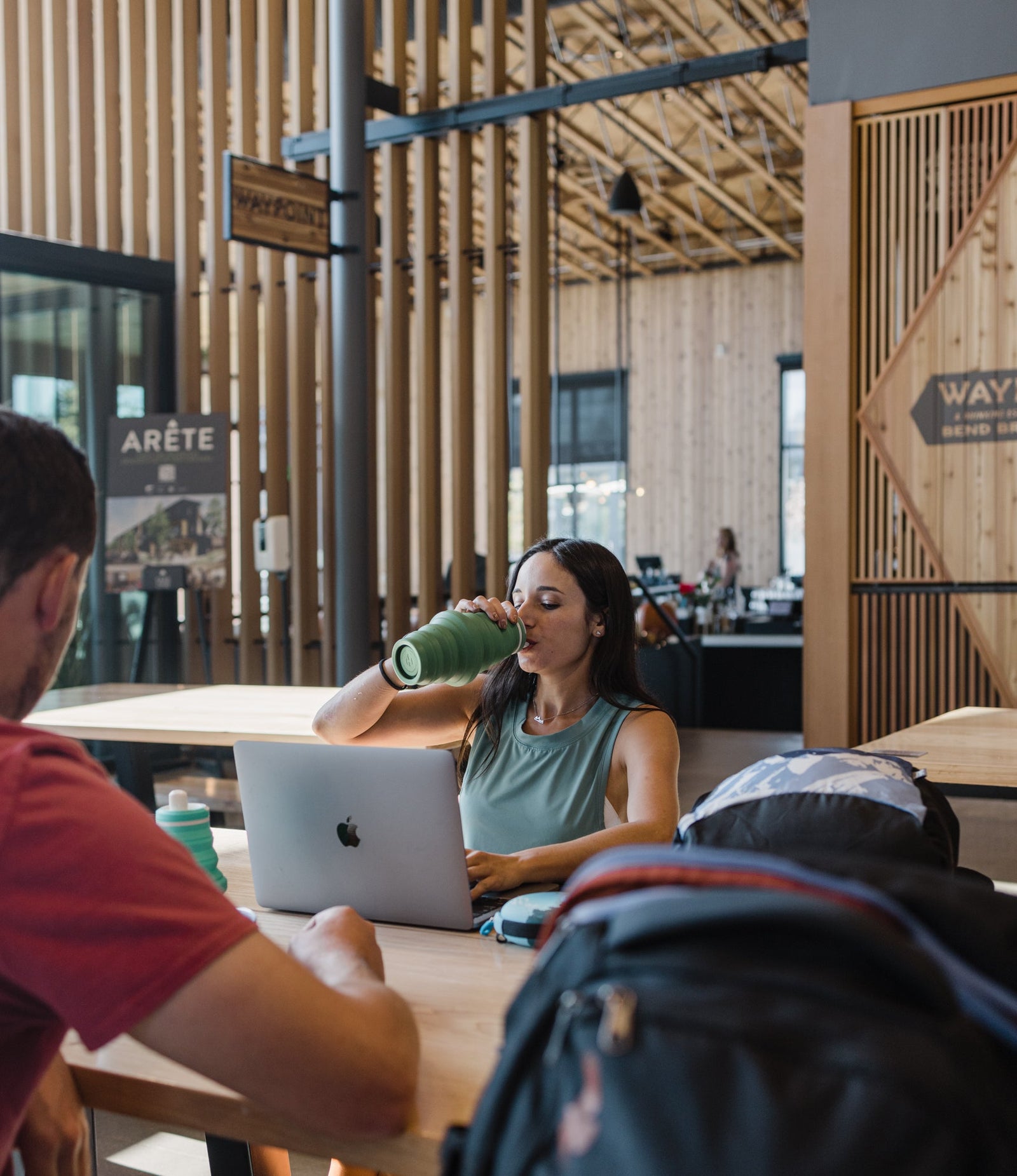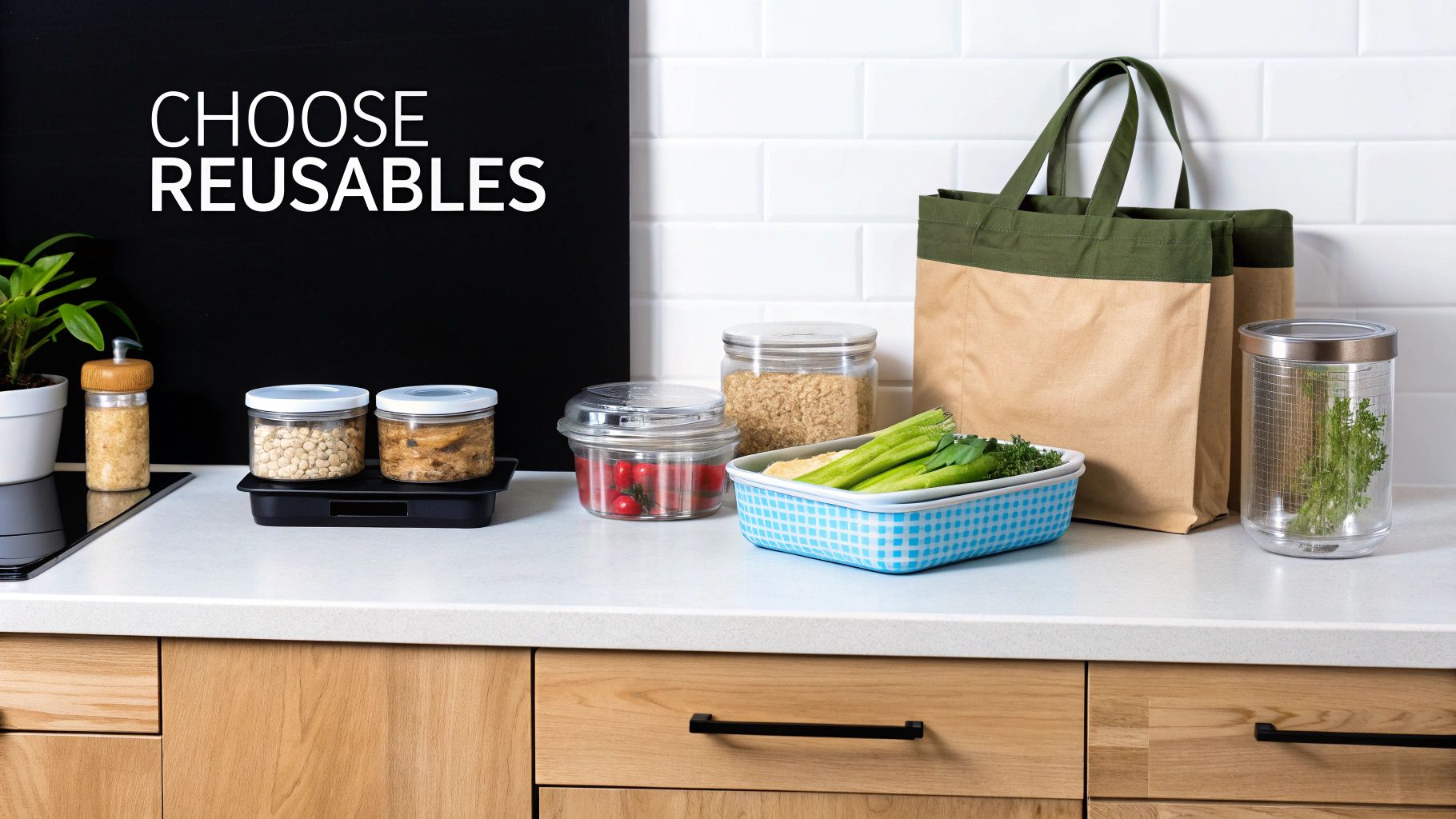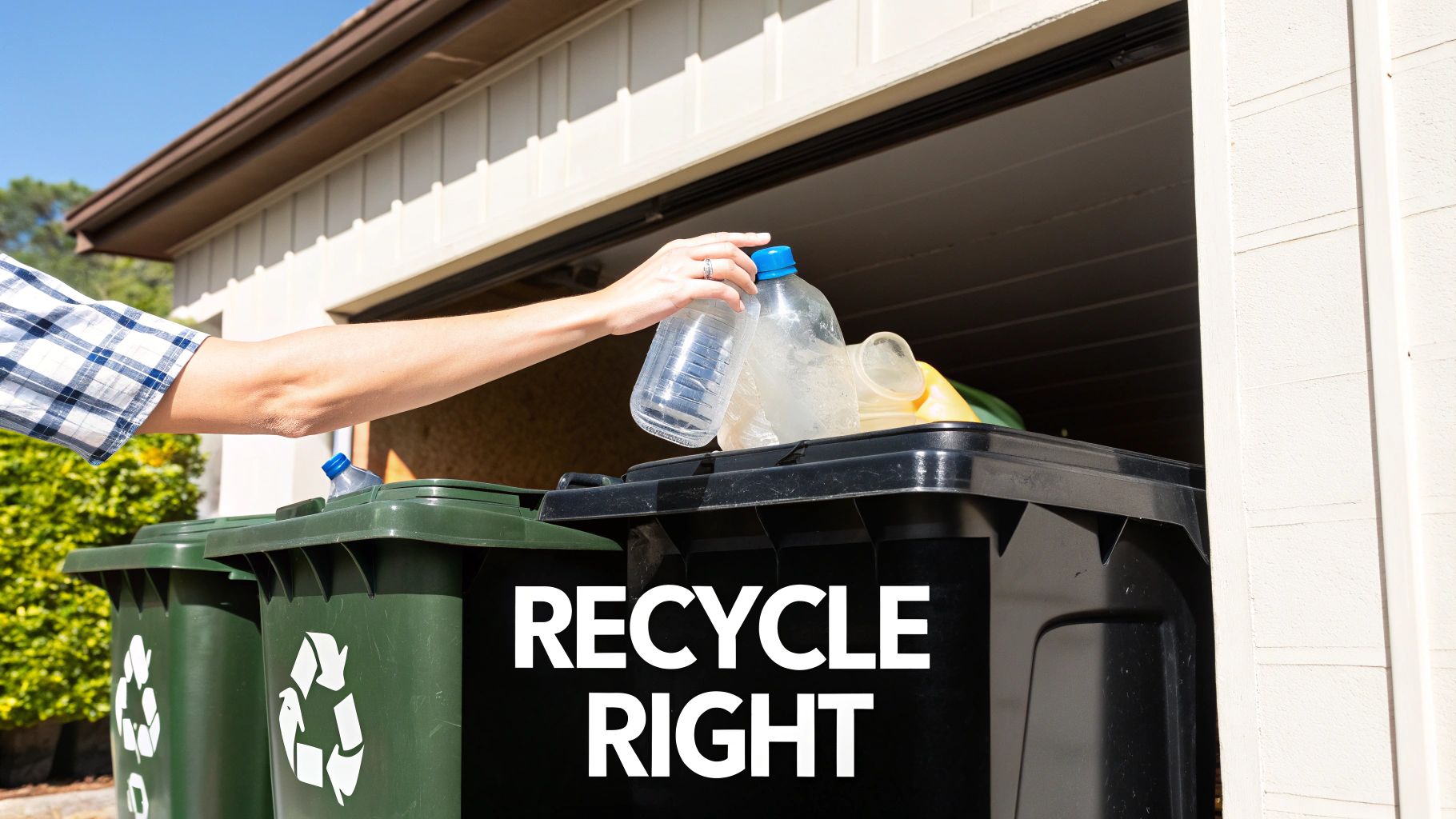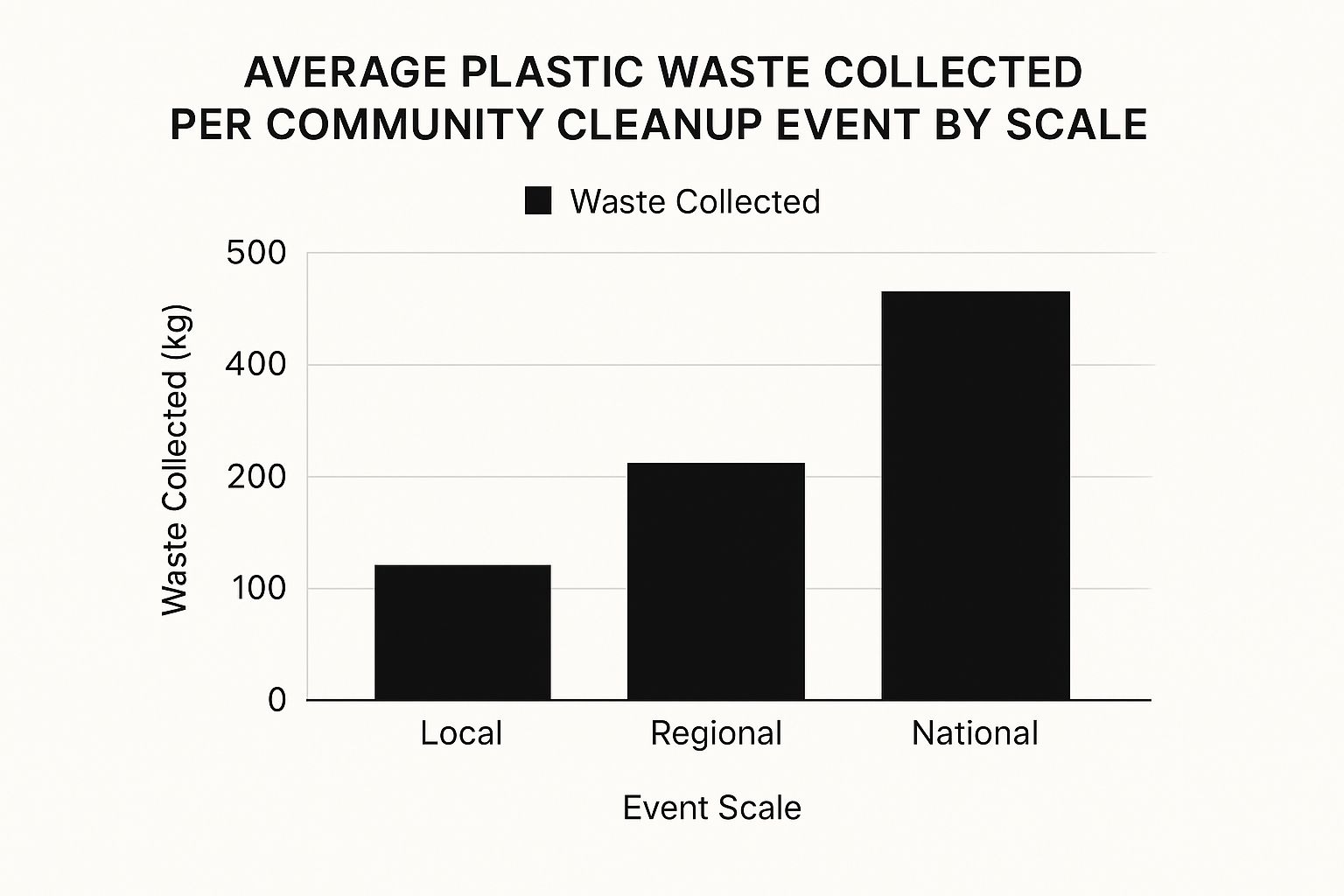How to Reduce Plastic Waste at Home and While Traveling

It's easy to feel like you're drowning in a sea of plastic. And honestly? That feeling is completely normal. The sheer scale of the problem can be paralyzing. But here’s something I’ve learned: tackling plastic waste isn't about some massive, overnight change.
It really starts with one small, conscious choice at a time. It’s about shifting your mindset from "disposable" to "durable." This isn't about achieving perfection; it's about making progress. That simple shift in how you see things is the most powerful tool you have.
Why Your Small Changes Actually Make a Huge Difference
Let's be real—when you hear about the massive plastic pollution problem, it's easy to think, "What can I possibly do?" But our collective habits are what got us here, and changing those habits is the only way out.
Think about it. The use of plastic takeout containers and delivery packaging continues to grow, a trend accelerated since 2020. A million single-use plastic bottles are sold every single minute. Each one of those items adds up, contributing to a global crisis that chokes our oceans and damages local ecosystems.
This is exactly why your individual choice has so much power. When you skip the plastic straw, bring your own coffee mug, or—my personal favorite—pack a reusable water bottle, you're doing more than just keeping one piece of plastic out of the landfill. You're starting a ripple effect.
The Ripple Effect: How One Choice Multiplies
Your actions send a message. You're telling businesses that you want sustainable alternatives. You're showing friends and family that there’s a better way. This is how real change happens—not with a single grand gesture, but with millions of small, practical decisions made every day.
Choosing a low-waste lifestyle isn't about going without. It’s about feeling empowered by finding smarter, better alternatives that last.
Just think about the immediate benefits:
- You’ll see a real drop in how much trash you produce.
- You'll save money. Investing once in a good reusable item beats paying for disposables over and over.
- You might just inspire someone in your life to make a change, too.
Making It Easy on Yourself
Here’s the secret to making new habits stick: they have to be convenient. If your eco-friendly swap is a hassle, you’re just not going to use it. We've all been there.
Take reusable water bottles. A big, bulky bottle is great until you have to lug it around all day. More often than not, it gets left at home. This is where a little bit of smart design makes all the difference. For your daily commute or a hike, a HYDAWAY collapsible bottle squishes down to fit in a pocket or clip onto a bag. It's there when you need it, and out of the way when you don't.
When you choose products designed for a real, on-the-go lifestyle, you remove the friction between your intentions and your actions. This makes reducing plastic waste not just possible, but easy.
Ultimately, this journey starts with a single step. You can learn more about how these choices add up and our mission to protecting the planet from plastic pollution. The goal isn’t to be perfect tomorrow, but to be a little better than yesterday, one reusable container at a time.
Creating a Low-Waste Kitchen You Love
The kitchen is the heart of the home, but let's be honest—it's also usually ground zero for single-use plastics. Between food packaging, cling wrap, and cleaning supplies, this is where our daily habits can generate a mountain of waste. But shifting to a low-waste kitchen isn't about a sudden, dramatic overhaul. It's about making smart, sustainable swaps that actually fit into your real life.

It all starts by taking a closer look at your routines. Your morning coffee, the lunch you pack for work, and how you store leftovers are all opportunities for small but powerful changes. Think about it: instead of automatically reaching for plastic wrap or a disposable Ziploc, what if you used a beeswax wrap or a reusable silicone bag? They get the same job done, just without the trash.
This is a bigger deal than it sounds. Globally, a staggering 40% of plastic production is for single-use items like bags and packaging that we use for a few minutes and then toss. The result? A mind-boggling 85% of this single-use plastic packaging ends up in landfills or polluting our environment. You can dig deeper into these numbers in this comprehensive breakdown of plastic waste statistics.
Start with Bulk Buying and Smart Storage
One of the most impactful changes you can make is to start buying in bulk. I know, it can sound a bit intimidating, conjuring up images of a perfectly curated, Instagram-worthy pantry. But you don't need that to get started. Just begin with a few staples you use all the time, like rice, oats, or nuts.
- Start small: Just bring a few glass jars or containers you already have to the store. No need to buy anything new.
- Focus on staples: Don't try to buy everything in bulk on your first trip. Pick two or three things and build the habit from there.
- Keep it organized: A quick label on your containers will keep your pantry from turning into a guessing game and ensure your food stays fresh.
When it comes to leftovers and meal prep, it's time to ditch those flimsy plastic containers that stain and warp. Glass is a fantastic alternative, but it can be heavy and take up a ton of cabinet space. This is where modern, space-saving designs are a game-changer. HYDAWAY’s collapsible food bowls are perfect for storing last night's dinner or packing lunch. They pop open when you need them and then fold down completely flat, making a low-waste lifestyle feel way less cluttered and a lot more manageable.
Rethink Your Daily Routines
Now, think about all the little plastics that sneak into your day without you even realizing it. That plastic fork and knife that comes with your takeout salad? It all adds up. The easiest fix is simply being prepared.
The secret to making sustainable choices stick is convenience. If a reusable item is easy to carry and use, it’ll become second nature in no time.
I find that creating a small "on-the-go" kit for my bag or car makes all the difference. It doesn't have to be complicated—just a reusable coffee cup, a water bottle, and a compact cutlery set. Tucking a reusable bamboo cutlery set in your bag means you can politely refuse the disposable kind without a second thought, whether you're at a food truck festival or the office cafeteria.
It’s these small, prepared moments that stop a surprising amount of plastic from ever entering your life. By redesigning these tiny daily habits, you'll start to build a kitchen—and a lifestyle—that you can feel genuinely good about.
Building Sustainable Habits for Daily Life
It’s one thing to get a handle on plastic waste at home, but life rarely stays put. Your daily commute, that spontaneous coffee run, or the errands you run after work—these are the moments where our best intentions often crash into the convenience of single-use plastics.
The secret to winning these daily battles isn’t about sheer willpower. It’s about being prepared.

This is where a “sustainability go-kit” becomes your best friend. It doesn’t need to be huge or complicated. We’re talking about a small pouch you can stash in your car, toss in your backpack, or leave in your work tote. Having a few key items on hand makes saying "no, thank you" to disposables feel like second nature.
Assemble Your Sustainability Go-Kit
Think of this as your everyday toolkit for living with less plastic. It’s what empowers you to handle whatever the day throws your way without leaving a trail of trash behind. To really make these habits stick, it helps to have a solid grasp of understanding environmental stewardship—it’s the “why” that fuels these small but powerful actions.
Your go-kit should fit you, but a great place to start is with these basics:
- A Compact Shopping Bag: Forget that growing collection of plastic bags under the sink. A lightweight, foldable tote takes up virtually no space and is a lifesaver for those unplanned grocery stops.
- Reusable Utensils: A simple bamboo or metal fork-and-spoon set means you can politely decline the flimsy plastic cutlery that comes with your lunch order.
- A Reusable Napkin: A small cloth napkin is a simple swap that not only cuts waste but also feels a little nicer to use than a flimsy paper one.
Of course, the most critical item in your kit is the one you’ll reach for constantly: your water bottle. This is where so many of us stumble. Let’s be honest, traditional reusable bottles can be bulky and a real pain to lug around once they’re empty.
The HYDAWAY Advantage On the Go
The real star of any go-kit is a reusable that fits your life, not one that makes you adjust your life around it. This is exactly the problem the HYDAWAY collapsible water bottle was designed to solve. It gives you all the perks of a sturdy, reusable bottle when you need hydration, but then it squishes down to just over an inch thick when you don’t.
Having a reusable bottle that can slip into your pocket or clip onto a bag removes the biggest barrier to staying hydrated without waste—the inconvenience of carrying a bulky, empty container.
Suddenly, you have a bottle that’s no big deal to bring to a concert, through airport security (empty, of course!), or on a quick afternoon walk. It makes refusing a single-use plastic bottle the easiest choice you'll make all day. That simple, brilliant design makes the habit feel effortless, not like a chore.
This mindset can extend beyond just your water bottle. For example, next time you grab a coffee, try asking for it "for here" in a real mug, even if you’re only staying for five minutes. That tiny shift in habit prevents another cup and plastic lid from heading to the landfill. It’s these small, consistent actions that truly add up to a more sustainable life.
How to Reduce Plastic Waste When You Travel
Traveling is one of life’s great joys, but let’s be honest—it can throw our best sustainable intentions for a loop. When we're out of our daily routine, the convenience of single-use plastics is everywhere. Think airport water bottles, tiny hotel toiletries, and endless takeout containers.
But here’s the good news: with a little bit of planning, you can see the world without leaving a trail of plastic in your wake.
Stay Hydrated and Fed Without the Trash
Let's start with two of the biggest plastic culprits on any trip: food and drinks. Whether you're grabbing a snack on a long road trip or trying to stay hydrated before a flight, it’s far too easy to end up with a mountain of wrappers and bottles. The right gear changes everything.
For road trips, skip the pre-packaged gas station snacks and pack your own in reusable containers. HYDAWAY’s stackable, collapsible food containers are a game-changer for this. They keep everything fresh on the way there and collapse down to almost nothing for the trip home, freeing up valuable space in your car.
Flying presents its own hydration challenges. You can’t get a full water bottle through security, which usually means buying an overpriced plastic one at the gate. The simple solution? Bring an empty, reusable bottle. The HYDAWAY 25oz collapsible water bottle was practically made for this. It goes through security totally flat and then you can fill it up at a water fountain on the other side.
The most effective way to reduce plastic waste while traveling is to make reusability effortless. When your gear is compact and convenient, sustainable choices become second nature.
Navigating New Places with Less Waste
Once you’re at your destination, the temptation for convenience continues. Exploring a local street food market is an amazing way to soak up the culture, but it often comes with a side of plastic plates and cutlery. An easy fix is to toss a compact utensil set into your daypack.
You can also make a difference right at your hotel. Politely let the front desk know you won’t be needing the tiny plastic bottles of shampoo or the disposable cups. It might seem like a small gesture, but when thousands of travelers do the same, it sends a clear message to the hospitality industry.
The impact of our collective waste is staggering. Community cleanups reveal just how quickly it all adds up.

Seeing these numbers really drives home why refusing even a single piece of plastic matters so much, especially when we're exploring new places.
To make it even easier, here's a quick-reference checklist comparing common travel items with their plastic-free alternatives to help you pack smarter.
Your Sustainable Travel Packing Checklist
| Travel Essential | Conventional Plastic Item | Sustainable Alternative |
|---|---|---|
| Hydration | Single-use water bottles | Collapsible, reusable water bottle |
| Toiletries | Mini plastic shampoo/conditioner bottles | Solid shampoo & conditioner bars |
| Snacks | Pre-packaged chips and bars | Homemade snacks in reusable containers |
| Coffee/Tea | Disposable coffee cups | Collapsible travel mug |
| Dining Out | Plastic cutlery & straws | Reusable bamboo or metal utensil set |
| Shopping | Plastic shopping bags | Foldable, lightweight tote bag |
Packing a few of these sustainable swaps doesn't just cut down on your personal waste—it makes your travel experience smoother and more mindful.
Making Sense of Recycling and Waste Management
Even when we do our best to reduce and reuse, some waste is just unavoidable. That’s where good old recycling and smart waste management come in, but let's be honest—it’s a confusing landscape. The most important thing to remember is that 'reduce' and 'reuse' will always pack a bigger punch than 'recycle.' The recycling process itself is complicated, uses a ton of energy, and sadly, a lot of what we hopefully toss in the blue bin never actually makes it to a second life.
A huge problem is something called “wish-cycling.” This is when we throw a questionable item into the recycling bin, crossing our fingers that it's the right thing to do. While it comes from a good place, this habit can contaminate an entire batch of perfectly good recyclables. Just one greasy pizza box or the wrong type of plastic can doom the whole lot to the landfill.
It's a tough reality to face. By 2025, we're on track to generate a staggering 225 million tonnes of plastic waste globally. Despite that mind-boggling number, only about 9% of plastic waste actually gets recycled. You can read more about these global plastic waste trends on letsrecycle.com. This is exactly why getting better at managing our waste is so critical.
Beyond the Blue Bin
To give your stuff the best shot at being recycled, you really have to know your local rules, which can be wildly different from one town to the next. The basics usually involve rinsing out containers to get rid of food gunk and knowing which plastics your facility can handle. Those little numbers in the triangles are just a guide; they don't guarantee that your local system can process them.
The single best recycling habit you can build is a clean one. When you make sure your items are clean and sorted correctly, you massively boost the chances they'll actually be recycled instead of gumming up the works.
But managing waste isn't just about recycling. There are other powerful ways to keep things out of landfills.
-
Composting: Why let food scraps rot in a landfill when they can become fantastic, nutrient-rich soil? Many cities are now offering curbside compost pickup, but starting a small bin in your own backyard is also a great option.
-
Brand Take-Back Programs: More and more companies are finally getting on board. You're seeing brands like Amazon making a real effort to ditch plastic packaging for recyclable paper mailers. Keep an eye out for companies that have programs to take back their own products or packaging for proper recycling.
-
Community Cleanups: Getting involved in a local cleanup is one of the most direct ways to see the problem and be part of the solution. It’s a pretty stark visual reminder of how much waste ends up in our environment and why the small choices we make every day really do add up.
Every single thing you keep out of the landfill—whether by composting, recycling correctly, or grabbing a reusable HYDAWAY bowl instead of a disposable one—makes a difference. It’s all about being more intentional with our choices, from start to finish.
Got Questions About Cutting Down on Plastic? We've Got Answers
Diving into a low-waste lifestyle can feel like learning a new language, and it’s totally normal to have questions. You might be wondering about the cost, where to even begin, or how to keep going when it feels like you're swimming against a tide of plastic.
Let’s clear up some of those common sticking points.
And remember, this isn't about getting a perfect score. If you're new to this, it helps to understand what zero waste truly means—it’s far more about making conscious choices than hitting some impossible, flawless standard.
Doesn't a Low-Plastic Lifestyle Cost a Lot to Get Started?
Not really. While it's true some reusables have an upfront cost, they almost always save you money in the long run. Just think about what you spend on bottled water every week, or grabbing a coffee in a disposable cup each morning. It adds up fast.
Investing once in a solid reusable, like a HYDAWAY collapsible bottle, pays for itself surprisingly quickly. Plus, some of the most effective habits are completely free. Saying "no thanks" to a plastic bag or using the glass jars you already have for food storage doesn't cost a dime.
What's the Single Best Change I Can Make to Start?
If you can only do one thing, make it this: stop buying single-use plastic bottles and cups. It's that simple. We throw away billions of these every year, creating a mountain of waste that's completely avoidable.
This is probably the easiest habit to build and the one you'll notice the most.
Carrying your own water bottle is the gateway habit. It’s a small, daily act that has a ripple effect, making you more aware of all the other single-use plastics you encounter.
This is exactly why having a bottle that’s genuinely convenient matters so much. A bottle like a HYDAWAY, which squishes down to fit in a pocket or purse, removes the "it's a hassle to carry" excuse. It makes the foundational habit feel automatic.
How Can I Stay Motivated When It Feels Like a Drop in the Ocean?
It’s easy to feel like your small actions don't matter, but they send powerful signals. Every time you choose a reusable option, you’re telling businesses what you value. You're creating demand for more sustainable products, and believe me, you're influencing the people around you more than you know.
Look at the big picture for proof. In 2024, California passed a landmark law requiring a 25% reduction in single-use plastic packaging and foodware by 2032. That didn't happen in a vacuum; it happened because millions of individual customers showed they wanted something better. Focus on your own wins, and know you’re part of a massive global shift.
But What About the Plastics I Can't Avoid?
Look, progress over perfection. Right now, it's virtually impossible to cut out all plastic. Think about essential things like medicine bottles or certain foods packaged for safety. Don't let the things you can't control derail you from tackling the things you can.
You might not be able to refuse a plastic prescription bottle, but you can absolutely bring your own container to the butcher or a reusable bag to the farmers market. Acknowledge the plastics that are necessary for now, and pour your energy into the hundreds of other choices you get to make every single day.
Ready to make your first—or next—impactful change? The journey to reducing plastic waste is easier with the right gear. HYDAWAY creates ultra-portable, collapsible essentials that make sustainable choices simple and convenient. Explore our collection of space-saving bottles, bowls, and travel gear at https://myhydaway.com.



